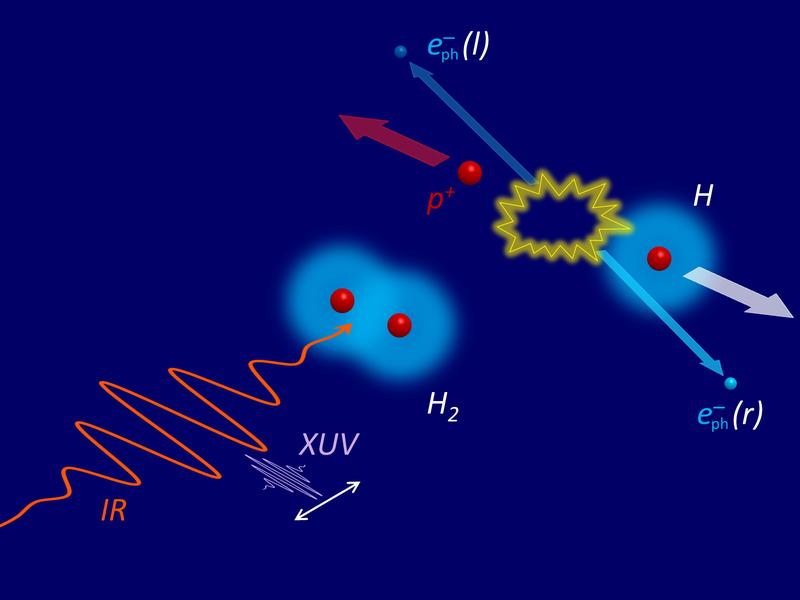Ultrafast steering of quantum-entangled electrons
Researchers at the Max Planck Institute for Nuclear Physics in Heidelberg have succeeded in selectively manipulating the motion of the electron pair in the hydrogen molecule. The emission direction of a photoelectron released by light (a photon) relative to the remaining bound electron in the cleaved neutral hydrogen atom can be controlled by the time interval between two laser flashes on the scale of a few hundred attoseconds (10⁻¹⁸ s). The adjustable emission asymmetry is based on the quantum entanglement between the bound electron and the spatially separated emitted electron.
Are we going left or right? A basic question with (usually) a simple answer on a hike in our classical world can be much more difficult to answer in the quantum world of elementary particles. Electrons and protons, the building blocks of molecules, can exist in states that go both left AND right at the same time, and make their decision to "materialize" in one of these choices only at the moment of their measurement (e. g. by impact on a particle detector). This phenomenon called quantum entanglement forms the basis of so-called quantum computers, in which information is stored and processed in quantum bits (Qubits) that allow for superpositions of simultaneously "right" AND "left", or "0" AND "1" in computer lingo. This makes quantum computation on such machines way more powerful than on classical computers, as basically multiple computations that would take a long time to run sequentially now all run at the same time. But there are problems: The programming of quantum computers is complex and requires many steps that take time — time during which the quantum processing unit can turn unstable (by "decoherence").
A team of physicists from MPIK Heidelberg — Farshad Shobeiry, Patrick Fross, Hemkumar Srinivas, Thomas Pfeifer, Robert Moshammer and Anne Harth (now Professor at Aalen University) — has now taken a significant step towards a dramatic (> 100.000 fold) speed-up of the control of entangled quantum states, from nanoseconds to femto- (10⁻¹⁵ s) or even attoseconds (10⁻¹⁸ s). The researchers studied the fundamental quantum dynamics of hydrogen molecules (two protons, two electrons) in their attosecond laser labs, picking up electron and protons after their interaction with these ultrashort flashes (pulses) of light. They found that the emission direction of electrons with respect to the protons can be modified by delaying attosecond pulses with respect to the maxima and minima of a laser light wave on a time-scale of less than a femtosecond. A general theory model explained this finding by the above-mentioned superposition of states: Two electrons of the molecule are quantum-mechanically entangled even though they are in different locations (one of them flying away isolated, the other still bound to a proton). The theory also showed that these states, which are similar to co-called Bell-states (a corner stone of quantum information theory), can be modified by attosecond delays between a high-frequency (extreme ultraviolet, XUV) and a low-frequency (infrared, IR) light flash.
While it is too early to design a viable quantum computer based on this idea, it provides the fundamental physics insights for programming quantum information on extremely short time scales. The generality of the model employed to explain the experiment conducted at MPIK Heidelberg allows, in principle, its translation from hydrogen to any other system in which two colors of light can be "mixed" to achieve quantum control of entangled states on the fundamental "ultrafast" time scale of electronic motion.
Wissenschaftlicher Ansprechpartner:
PD Dr. Robert Moshammer
MPI für Kernphysik
Phone: +49 6221 516-461
robert.moshammer@mpi-hd.mpg.de
Prof. Dr. Thomas Pfeifer
MPI für Kernphysik
Phone: +49 6221 516-380
thomas.pfeifer@mpi-hd.mpg.de
Prof. Dr. Anne Harth
Zentrum für Optische Technologien
Hochschule Aalen
Phone: +49 7361-576-4586
Anne.harth@hs-aalen.de
Originalpublikation:
Emission control of entangled electrons in photoionization of a hydrogen molecule
Farshad Shobeiry, Patrick Fross, Hemkumar Srinivas, Thomas Pfeifer, Robert Moshammer and Anne Harth
Scientific Reports 14, 19630 (2024). https://doi.org/10.1038/s41598-024-67465-0
Weitere Informationen:
https://www.mpi-hd.mpg.de/mpi/en/research/scientific-divisions-and-groups/quantum-dynamicscontrol/research/ionized-atomsmolecules-in-strong-fields-ag-moshammer Group “Ionizing Atoms and Molecules in Strong Fields” (Division Pfeifer) at MPIK
https://www.hs-aalen.de/en/facilities/12 Center for Optical Technologies (Hochschule Aalen)
Ähnliche Pressemitteilungen im idw



